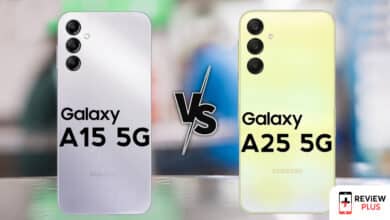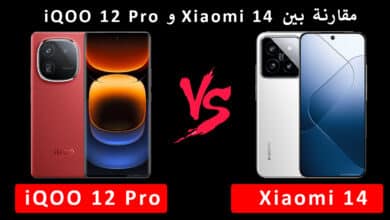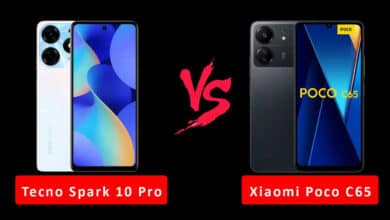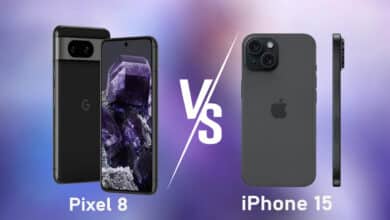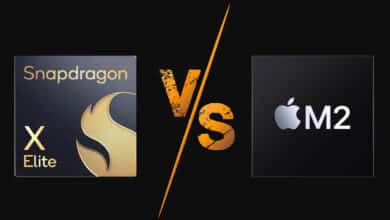This comparison shows the difference between the Google Tensor G3 processor and the Apple A17 Pro, which are found in the latest smartphones of both Google and Apple, which are the iPhone 15 Pro Max and the Google Pixel 8 Pro.
Comparison between Google Tensor G3 processor and Apple A17 Pro
The most expensive smartphone manufacturers do not have the ability to manufacture processing chips themselves, but rather resort to purchasing processors from other companies, and both Qualcomm and MediaTek are the main suppliers of the processing chips used in most phones.
But Apple and Google are excluded from this. Apple manufactures its processors itself using the manufacturing technology of the Taiwanese company TSMC, while Google manufactures its processors using Samsung chip technology.
Read also on Review Plus: Google Pixel 8 Pro vs Google Pixel 7 Pro: Comparison.
The partnership between phone manufacturers and chip manufacturers gives the former the ability to modify the processor and add more privileges that cannot be used on any other phone.
But in fact, it is not the only advantage of manufacturing chips internally, but rather the essence of the idea is to save billions of dollars in the manufacturing process compared to what could be spent to purchase Qualcomm or MediaTek processors.
The Google Pixel 8 series was announced a few days ago, and last September, the iPhone 15 Pro phones were launched. These phones come with completely new processors.
While the Pixel 8 phones are powered by the Tensor G3 processor, the iPhone 15 Pro phones are powered by the A17 Pro processor. This is not the first time, of course, as the new generation of Google phones usually comes with a new Tensor processor, since the Pixel 6 series.
As for the Pro series of iPhone phones, you usually get the new processor, while the basic models are satisfied with last year's processor.
There are certainly noticeable differences between the Tensor G3 processor and the A17 Pro processor, not only in terms of the general performance level, but also in terms of the features and capabilities supported by each processor.
A phone's processor is the basic architecture for many of the phone's components, including RAM capacity, supported storage capacity, the highest resolution camera sensors, communications modem generation, the highest screen resolution, and many other things.
So, to find out which one is better, we made a quick comparison between both processors. It's certainly not an ideal way to compare a phone like the iPhone 15 Pro Max to a phone Google Pixel 8 Pro. But if you want to know which chip relies on the best manufacturing technology and is the most energy efficient, perhaps this comparison will help you know which one is better between them.
The Apple A17 Pro processor is based on 3nm manufacturing technology

Every year, chip manufacturers make strenuous efforts to reduce the size of the node inside the processing chip. It is not an easy process, and requires a greater amount of material investment and manufacturing machinery.
But there is a reason why all this effort is needed just to reduce the node size. The smaller the node size, the more transistors the manufacturer can install. The larger the transistors inside the processor, the faster it is able to perform tasks.
The Apple A17 Pro processor is the first processor in the world with a manufacturing accuracy of 3 nm, and therefore it contains a larger number of transistors compared to the A16 Bionic processor, which relies on a manufacturing accuracy of 4 nm.
The number of transistors inside the A17 Pro has reached 19 billion transistors, compared to 16 billion transistors inside the A16 Bionic processor. The difference is equivalent to 3 billion transistors, which is a very huge difference, which gives the new generation of iPhone Pro phones the possibility of outperforming the previous generation by a large margin.
As for the Tensor G3 processor, Google did not reveal the manufacturing technology used in the processor, and the number of transistors inside it was not revealed either. But from the leaks, it appears that it still uses 4nm manufacturing technology, which means that the superiority will be very noticeable in favor of the Apple processor.
Therefore, regardless of the processor frequency, the number of transistors plays a big role in improving its performance within all tasks. In addition, the more manufacturing technology develops, the more energy efficient it becomes. This is another incentive that gives the manufacturer the ability to add more resources within the processor and not consume larger percentages of energy compared to the processor of the previous year.
The Tensor G3 processor has a central processor consisting of 9 cores

Google has been quite discreet about clarifying the specifications of the Tensor G3 processor. But through its previous statements, it confirmed, through one of the processor’s officials, that the company gives greater attention to the capabilities of artificial intelligence at the expense of performance.
In other words, Google doesn't care much about the performance on the phone because it believes that the overall performance is more than enough for all types of tasks. Whether we agree or disagree on this logic, this is the approach that Google takes with its own processors.
Therefore, Google did not disclose the exact components of the Tensor G3 processor. But many reports indicate that the processor has a 9-core CPU.
As for the A17 Pro processor, it contains only a six-core central processor. At first glance, you might think that the balance is in favor of the Google processor, but this is not the truth.
The A17 Pro processor contains two large cores with a frequency of 3.78GHz and four high-efficiency cores with a frequency of 2.11GHz. While the Tensor G3 processor contains one large core clocked at only 3GHz, in addition to 4 medium-performance cores clocked at 2.35GHz and 4 high-efficiency cores clocked at 2.15GHz.
When you look at the number of cores, you may think that the Google processor is the best, but the number does not tell you the whole truth. The reason is that the Apple processor contains two large cores with a very fast frequency compared to the single large core in the Google processor, which is still slower by approximately 780Hz.
In short, the A17 Pro processor is not only able to outperform the Google processor, but it is able to deliver almost double its performance, not only because of the additional large core but also because of the higher speed at which both of its first cores operate.
Read also: iPhone 15 VS Samsung S23: comparing Specs and prices
The A17 Pro processor opens the way to a new dimension in the world of gaming and graphics

During the unveiling of the Apple A17 Pro processor, Apple stated that this processor is not only sufficient for the most common smartphone games, but is also capable of handling games such as RE 4, Death Stranding, and AC Mirage very smoothly.
We never expected a smartphone to be able to run these kinds of games, at least not now. The only possibility to play similar games was through cloud-based services.
Therefore, for Apple to acknowledge this capability and actually provide it on the ground is a fatal blow to all other smartphones. As for Google, it did not go into any details related to games, which means that the Pixel 8 Pro phone is not the ideal choice for fans of advanced games like the ones we mentioned a moment ago.
It is unfortunate that Tensor processors remain behind Apple and Qualcomm processors. But as we mentioned a moment ago, Google does not pay as much attention to performance as it does to the capabilities of artificial intelligence on the phone.
Thus, although support for ray tracing technology is provided from the GPU inside the Tensor G3, this does not mean anything significant in the world of more resource-hungry Android gaming. It may be able to run the game, but it can't keep up with the same performance as a processor like the A17 Pro.
Tensor G3's entire focus towards AI technologies is at the expense of computational performance

Since the first generation of the Google Tensor processor, Google has stated that it wanted to develop its own processing, not in order to enhance the performance of computer processing on Pixel phones, but rather it wanted to advance the capabilities of artificial intelligence, and this matter became more clear through the promotional offers presented by Google during the announcement conference. Google Pixel 8.
According to Google's statements, the Tensor G3 processor is able to improve the performance of the most complex generative AI by a difference of 150 times better than the performance on the Tensor G2 processor.
This feature opens up scope for more AI-based features including photo editing, blocking spam calls, removing background noise from the microphone, removing noise from video recordings, and a lot of cooler, smarter stuff.
With new features like Best Take that gives you the ability to replace faces from photos and tweak facial expressions, only possible with the more sophisticated AI capabilities afforded by the Tensor G3 processor. Also, Magic Eraser is still a nice feature to easily remove items and objects from photos, even if the feature still requires more work to fix some bugs with upcoming updates.
They seem to be just normal features of professional photo editing apps on Google Play Store. But when you consider that you can use gadgets like these without requiring any additional purchases, it's definitely a perk worth sacrificing.
Although the A17 Pro processor excels in terms of performance, it clearly does not have the same amount of intelligence as the Tensor G3, especially when it comes to generative AI capabilities.
Using these features will not be of interest to everyone, but for others, they are a set of the most important features and qualities required in a phone.
Read also: Google Pixel 6 Pro vs Samsung S22 Ultra comparison
Conclusion
As we noted at the beginning, this is not an ideal way to compare a phone like the iPhone 15 Pro Max with a phone like the Pixel 8 Pro. But the gist of the idea here is that you can determine the best processor based on your business requirements.
The A17 Pro processor is still the most powerful without any doubt. It allows you to handle multitasking better, enjoy some of the best flagship gaming titles in the mobile world, and will be a more reliable choice for future demands.
The A17 Pro processor is based on a more advanced manufacturing node and is therefore the most efficient. Regardless of the initial heating issues that were solved, it is still the most power efficient, and along with the software improvements, it ensures you get epic battery life and longer uptime.

